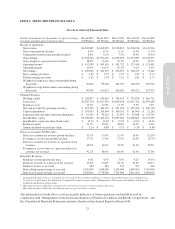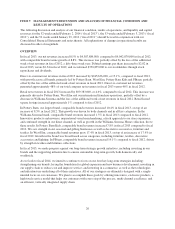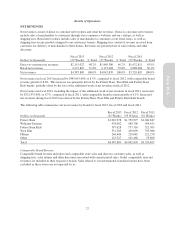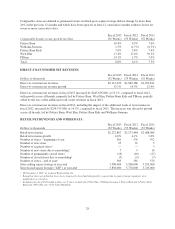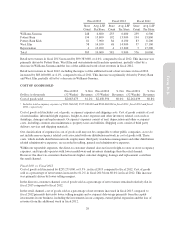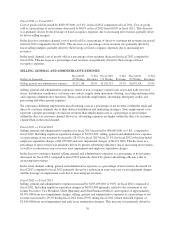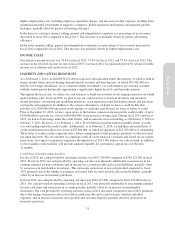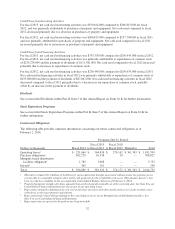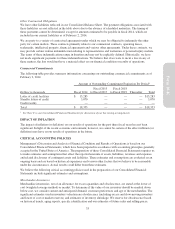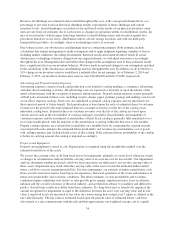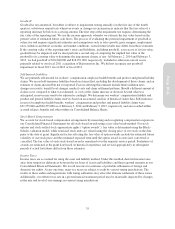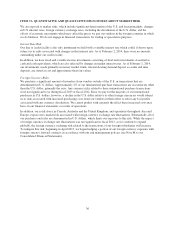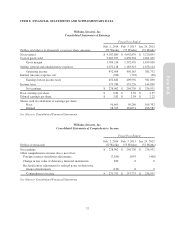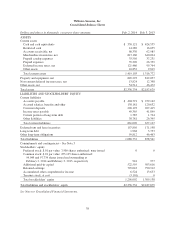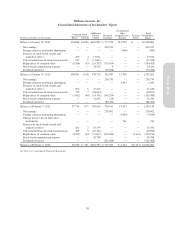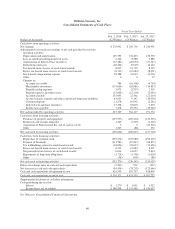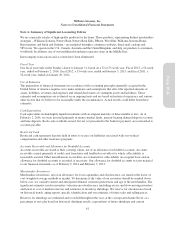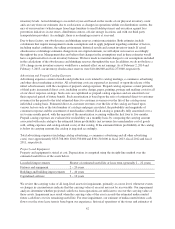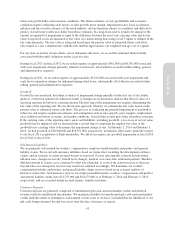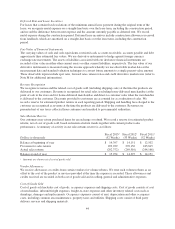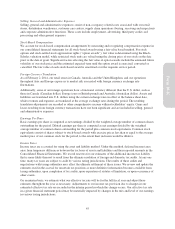Pottery Barn 2013 Annual Report Download - page 49
Download and view the complete annual report
Please find page 49 of the 2013 Pottery Barn annual report below. You can navigate through the pages in the report by either clicking on the pages listed below, or by using the keyword search tool below to find specific information within the annual report.
Goodwill
Goodwill is not amortized, but rather is subject to impairment testing annually (on the first day of the fourth
quarter), or between annual tests whenever events or changes in circumstances indicate that the fair value of a
reporting unit may be below its carrying amount. The first step of the impairment test requires determining the
fair value of the reporting unit. We use the income approach, whereby we estimate the fair value based on the
present value of estimated future cash flows. The process of evaluating the potential impairment of goodwill is
subjective and requires significant estimates and assumptions such as sales growth, gross margins, employment
rates, inflation and future economic and market conditions. Actual future results may differ from those estimates.
If the carrying value of the reporting unit’s assets and liabilities, including goodwill, is in excess of its fair value,
goodwill may be impaired, and we must perform a second step of comparing the implied fair value of the
goodwill to its carrying value to determine the impairment charge, if any. At February 2, 2014 and February 3,
2013, we had goodwill of $18,946,000 and $18,951,000, respectively, included in other non-current assets,
primarily related to our fiscal 2011 acquisition of Rejuvenation Inc. We did not recognize any goodwill
impairment in fiscal 2013, fiscal 2012 or fiscal 2011.
Self-Insured Liabilities
We are primarily self-insured for workers’ compensation, employee health benefits and product and general liability
claims. We record self-insurance liabilities based on claims filed, including the development of those claims, and an
estimate of claims incurred but not yet reported. Factors affecting this estimate include future inflation rates,
changes in severity, benefit level changes, medical costs and claim settlement patterns. Should a different amount of
claims occur compared to what was estimated, or costs of the claims increase or decrease beyond what was
anticipated, reserves may need to be adjusted accordingly. We determine our workers’ compensation liability and
product and general liability claims reserves based on an actuarial analysis of historical claims data. Self-insurance
reserves for employee health benefits, workers’ compensation and product and general liability claims were
$21,755,000 and $20,275,000 as of February 2, 2014 and February 3, 2013, respectively, and are recorded within
accrued salaries, benefits and other within our Consolidated Balance Sheets.
Stock-Based Compensation
We account for stock-based compensation arrangements by measuring and recognizing compensation expense in
our Consolidated Financial Statements for all stock-based awards using a fair value based-method. For stock
options and stock-settled stock appreciation rights (“option awards”), fair value is determined using the Black-
Scholes valuation model, while restricted stock units are valued using the closing price of our stock on the date
prior to the date of grant. Significant factors affecting the fair value of option awards include the estimated future
volatility of our stock price and the estimated expected term until the option award is exercised, converted or
cancelled. The fair value of each stock-based award is amortized over the requisite service period. Forfeitures of
awards are estimated at the grant date based on historical experience and revised appropriately in subsequent
periods if actual forfeitures differ from those estimates.
Income Taxes
Income taxes are accounted for using the asset and liability method. Under this method, deferred income taxes
arise from temporary differences between the tax basis of assets and liabilities and their reported amounts in our
Consolidated Financial Statements. We record reserves for estimates of probable settlements of foreign and
domestic tax audits. At any one time, many tax years are subject to audit by various taxing jurisdictions. The
results of these audits and negotiations with taxing authorities may affect the ultimate settlement of these issues.
Additionally, our effective tax rate in a given financial statement period may be materially impacted by changes
in the mix and level of our earnings in various taxing jurisdictions.
35
Form 10-K


